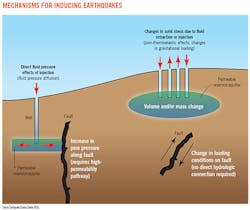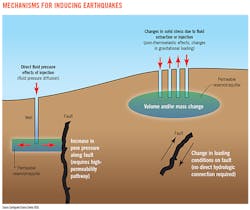The US Geological Survey has released two separate reports this year in its ongoing studies on possible consequences of unconventional oil and gas activities.
One study involved seismicity, and one involved water-quality risks.
USGS developed preliminary models that aim to calculate how often earthquakes are expected to occur in the next year, and how hard the ground will likely shake as a result.
The report also identified issues to be resolved in development of a final hazard model, scheduled for release by Dec. 31.
The US Department of the Interior agency said its preliminary models should be considered experimental and not be used to make decisions.
A sharp increase in earthquake activity since 2009 in the eastern and central US has been potentially linked to wastewater injection wells. Yet, most wastewater injection wells do not produce tremors that can be felt, USGS indicated.
USGS scientists identified 17 areas within Alabama, Arkansas, Colorado, Kansas, New Mexico, Ohio, Oklahoma, and Texas where seismicity rates have been high since 2000 and have increased substantially since 2009.
Scientists analyzed earthquakes in these zones and considered rates, locations, maximum magnitude, and ground motions.
Noting that an Apr. 23 report looked at the central and eastern US, USGS said future research will incorporate data from western states as well.
Fracturing water risks
In a separate report, USGS said more data and research will be necessary to better understand potential water-quality risks associated with unconventional development.
"We mined the national water-quality databases from 1970-2010 and were able to assess long-term trends in only 16% of the watersheds with unconventional oil and gas resources," said Zachary H. Bowen, a USGS scientist and principal author of an article that appeared in the American Geophysical Union's Water Resources Research.
He said not enough information was available to assess potential water-related effects of oil and gas development over large geographic areas. Bowen works in the Ecosystems Dynamics Branch at USGS's Fort Collins, Colo., Science Center.
The researchers used existing USGS and US Environmental Protection Agency data sets.
Based on limitations of sample sizes, researchers were unable to estimate trends in specific conductance (SC) and chloride (Cl) during the 40-year period in 16% of the watersheds with unconventional oil and gas resources, an abstract of the study said.
Trends were assessed relative to spatiotemporal distributions of fractured wells, it indicated.
"Results from this limited analysis suggest no consistent and widespread trends in surface water quality for SC and Cl in areas with increasing unconventional oil and gas development," the abstract said.
Findings also highlighted existing national databases' limitations for addressing questions regarding unconventional oil and gas development and water quality, it added.


